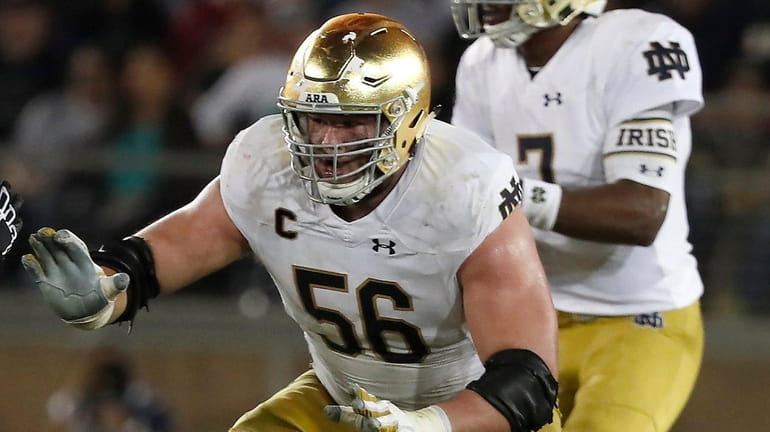Giants’ Hal Hunter sees changing landscape for offensive linemen

Notre Dame offensive lineman Quenton Nelson against Stanford on Nov. 25, 2017, in Stanford, Calif. Credit: AP / Tony Avelar
Hal Hunter likes what he’s seen from Quenton Nelson, the Notre Dame guard who many have pegged as a surefire Pro Bowler and the top offensive lineman in this month’s draft. But he has a question when it comes to Nelson.
“Why aren’t there 20 of him this year?” the Giants’ new offensive line coach asked on Wednesday. “Why is there only one of him?”
Hunter spent a good portion of the past year exploring the answer to that one. After 35 consecutive years of coaching, he took a year off from the profession after he parted ways with the Browns following the 2016 season. He spent that time visiting college football fields around the country trying to reconcile the problem that is facing so many NFL teams these days. Namely, how do you turn college offensive linemen into professional ones?
“I wanted to go see what exactly is going on in college football,” Hunter said. “How much technique work they’re doing. I wanted to see what’s being coached. I was anxious to see it.”
What he found was a variety of approaches and a quickly changing landscape in the sport.
“With all the two-point stance and the zone reads, there’s not a lot of offenses like Wisconsin and Iowa, where they are downhill run the ball,” Hunter said. “You watch some of these teams, really good teams, like I’m at Ohio State and that’s a great football team; it’s a great offense. But I’ll tell you what, it’s like a version of the Wing-T. They have a back going this way and a back going this way and the quarterback is reading this and there are guys going every way. I don’t know how you block for those guys. These guys are all working out of two-point stances and zoning here and zoning there. It’s just different. Then you go and watch someone like Wisconsin and they’re banging and they’re double-teaming and they’re man-blocking and smashing it up. You see that and it’s more familiar.”
Even schools that were pipelines to the NFL at the position are changing.
“Remember when Alabama was a two-back downhill pound-the-ball offense?” he said. “What are they doing now? They’ve become zone-read and all that type of stuff, so they’ve changed a little bit. How many offensive linemen are coming out of Alabama this year as opposed to years past, when you had two or three each year?”
The gap between what college offensive linemen must do and what NFL linemen do has become so broad that there is a league-wide crisis when it comes to finding players who can fit in the pros.
“At the end of the day, if you watch football, obviously the college game, a lot of it is really different,” Giants general manager Dave Gettleman said at the NFL Combine in February. “Some of these kids, there are guys that start for four years and the only time they have their hand in the dirt is if they fall down. It is two points the whole time and occasionally you will see them in the four-point on the goal line.”
So a lot of the scouting work done on college linemen is about projecting rather than observing.
“You look for the things that all the great ones can do,” Gettleman said. “You have to look at all the basics. Does he play with a base? Can he roll his hips? Can he do this? Can he do that? You will find guys in the two-point that can do that.”
More often than not, though, the difference is tough to bridge. That’s where position coaches come in.
“When I coached college football, my job was not to produce NFL offensive linemen,” Hunter said. “My job was to win football games. Colleges aren’t charged with developing, they’re charged with winning games and doing the best they can in college football. It’s our job to take those guys and coach them into being able to function within our system.”
Now that he is back in the NFL coaching circles after his year-long break, Hunter doesn’t have all the answers. But he does have a perspective on where young offensive linemen are coming from. Some programs, he said, essentially stretch at the start of practice and then dive right into running plays. Others spend some time on fundamentals.
“There are some programs that year after year put out good-quality-coached offensive linemen,” Hunter said. “But the pool of offensive linemen is not what it’s been in the past. We all know that, we all see that.”
It’s why the Giants invested so heavily in the offensive line in free agency after years of trying to draft their way to a new offensive line, adding established players such as Nate Solder and Patrick Omameh rather than rolling the dice on picks. As the April 26-28 draft approaches, Hunter and the Giants will try to find linemen who are best suited to making the leap from the college game to the NFL. There aren’t a lot of them.
That’s why a player like Nelson is so special. So valuable. And, in this day and age, almost unique.

